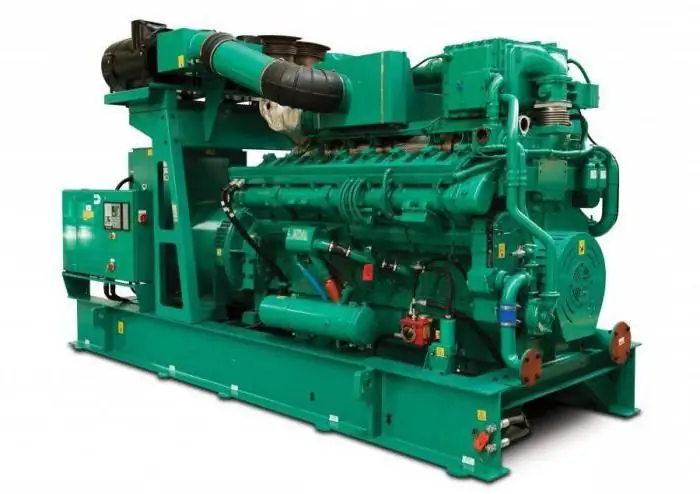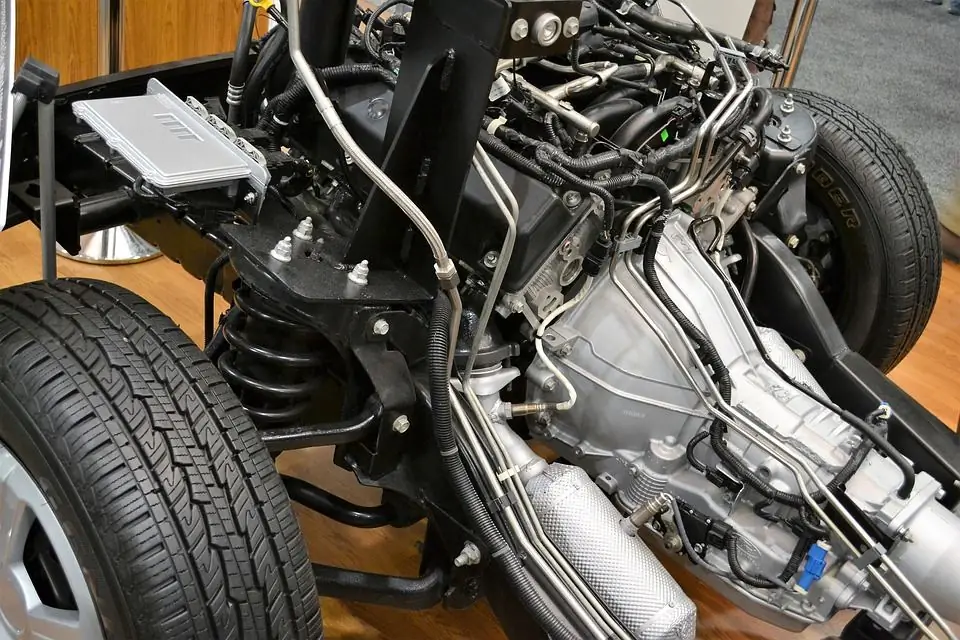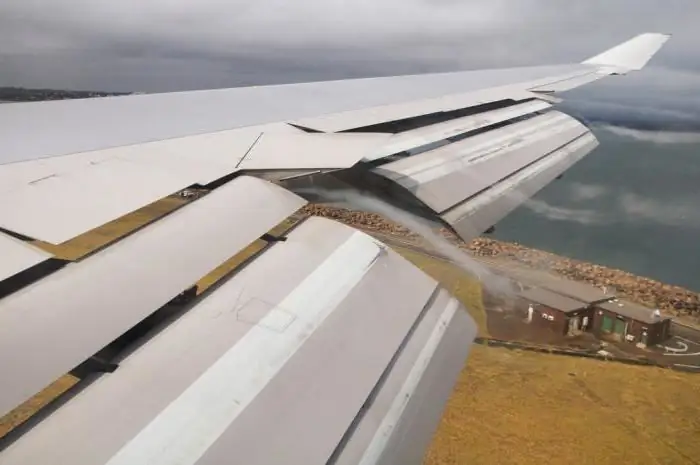2026 Author: Howard Calhoun | [email protected]. Last modified: 2025-01-24 13:10:26
Those people who flew on airplanes and paid attention to the wing of an iron bird, while it sits down or takes off, probably noticed that this part begins to change, new elements appear, and the wing itself becomes wider. This process is called wing mechanization.
General information
People have always wanted to drive faster, fly faster, etc. And, in general, with the plane it worked out quite well. In the air, when the device is already flying, it develops tremendous speed. However, it should be clarified here that a high rate of speed is acceptable only during direct flight. During takeoff or landing, the opposite is true. In order to successfully lift the structure into the sky or, conversely, land it, high speed is not needed. There are several reasons for this, but the main one is that you will need a huge runway to accelerate.
The second main reason is the tensile strength of the aircraft landing gear, which will be passed if taken off in this way. That is, in the end it turns out that for high-speed flights one type of wing is needed, and for landing and takeoff - a completely different one. What to do in such a situation? Howto create two pairs of wings fundamentally different in their design for the same aircraft? The answer is no. It was this contradiction that prompted people to a new invention, which was called the mechanization of the wing.

Angle of attack
In order to explain what mechanization is in an accessible way, it is necessary to study one more small aspect, which is called the angle of attack. This characteristic has the most direct relationship with the speed that the aircraft is capable of developing. It is important to understand here that in flight, almost any wing is at an angle with respect to the oncoming flow. This indicator is called the angle of attack.
Let's assume that in order to fly at low speed and at the same time maintain lift, in order not to fall, you will have to increase this angle, that is, lift the nose of the aircraft up, as is done on takeoff. However, it is important to clarify here that there is a critical mark, after crossing which the flow will not be able to stay on the surface of the structure and will break off from it. In piloting, this is called the separation of the boundary layer.

This layer is called the air flow, which is in direct contact with the wing of the aircraft and thus creates aerodynamic forces. With all this in mind, the requirement is formed - the presence of a large lifting power at low speed and maintaining the required angle of attack in order to fly at high speed. It is these two qualities that combine the mechanization of the aircraft wing.
Performance upgrades
To improvetakeoff and landing characteristics, as well as to ensure the safety of the crew and passengers, it is necessary to reduce the speed of takeoff and landing to the maximum. It is the presence of these two factors that led to the fact that the designers of the wing profile began to resort to the creation of a large number of different devices that are located directly on the wing of the aircraft. A set of these special controlled devices became known as wing mechanization in the aircraft industry.
Purpose of mechanization
Using such wings, it was possible to achieve a strong increase in the value of the lifting force of the apparatus. A significant increase in this indicator led to the fact that the mileage of the aircraft during landing along the runway was greatly reduced, and the speed with which it lands or takes off also decreased. The purpose of the mechanization of the wing is also that it has improved the stability and increased the controllability of such a large aircraft as an airplane. This became especially noticeable when the aircraft is gaining a high angle of attack. In addition, it should be said that a significant reduction in the speed of landing and take-off not only increased the safety of these operations, but also reduced the cost of building runways, since it became possible to reduce their length.

The essence of mechanization
So, speaking in general, the mechanization of the wing led to the fact that the take-off and landing parameters of the aircraft were significantly improved. This result was achieved by greatly increasing the maximum lift coefficient.
The essence of itprocess lies in the fact that special devices are added that increase the curvature of the wing profile of the apparatus. In some cases, it also turns out that not only the curvature increases, but also the direct area of \u200b\u200bthis element of the aircraft. Due to the change in these indicators, the flow pattern also changes completely. These factors are decisive in increasing the lift coefficient.
It is important to note that the design of the wing mechanization is carried out in such a way that all these details are controllable in flight. The nuance lies in the fact that at a small angle of attack, that is, when flying already in the air at high speed, they are actually not used. Their full potential is revealed precisely during landing or takeoff. Currently, there are several types of mechanization.

Shield
The shield is one of the most common and simplest parts of a mechanized wing, which copes quite effectively with the task of increasing the lift coefficient. In the wing mechanization scheme, this element is a deviating surface. When retracted, this element is almost closely adjacent to the lower and rear of the wing of the aircraft. When this part is deflected, the maximum lift force of the vehicle increases, because the effective angle of attack changes, as well as the concavity or curvature of the profile.
In order to increase the efficiency of this element, it is structurally executed so that when it deviates, it shifts back and at the same time to the trailing edge. Exactly like thisthe method will give the greatest efficiency of suction of the boundary layer from the upper surface of the wing. In addition, the effective length of the high-pressure zone under the aircraft wing increases.

Design and purpose of mechanization of an aircraft wing with slats
Here it is important to note right away that the fixed slat is mounted only on those aircraft models that are not high-speed. This is because this type of design greatly increases drag, which drastically reduces the aircraft's ability to reach high speeds.
However, the essence of this element is that it has such a part as a deflected toe. It is used on those types of wings that are characterized by a thin profile, as well as a sharp leading edge. The main purpose of this sock is to prevent the flow from breaking at a high angle of attack. Since the angle can constantly change during the flight, the nose is made completely controllable and adjustable so that in any situation it is possible to find a position that will keep the flow on the surface of the wing. This can also increase lift-to-drag ratio.

Flaps
The wing-flaps mechanization scheme is one of the oldest, as these elements were among the first to be used. The location of this element is always the same, they are located on the back of the wing. The movement they perform is also alwaysthe same, they always fall straight down. They can also move back a little. The presence of this simple element in practice proved to be very effective. It helps the aircraft not only when taking off or landing, but also when performing any other piloting maneuvers.
The type of this item may vary slightly depending on the type of aircraft on which it is used. The mechanization of the wing of the TU-154, which is considered one of the most common types of aircraft, also has this simple device. Some aircraft are characterized by the fact that their flaps are divided into several independent parts, and for some it is one continuous flap.
Ailerons and spoilers
In addition to those elements that have already been described, there are also those that can be classified as secondary. The wing mechanization system includes minor details such as ailerons. The work of these parts is carried out differentially. The most commonly used design is such that on one wing the ailerons are directed upwards, and on the second they are directed downwards. In addition to them, there are also elements such as flaperons. According to their characteristics, they are similar to flaps, these parts can deviate not only in different directions, but also in the same direction.
Spoilers are also additional elements. This part is flat and is located on the surface of the wing. Deflection, or rather rise, of the spoiler is carried out directly into the stream. Because of this, there is an increase in flow deceleration, because of this, the pressure on the upper surface increases. This leads to a decreasethe lift force of a given wing. These wing elements are sometimes also referred to as aircraft lift controls.

It is worth saying that this is a rather brief description of all structural elements of the aircraft wing mechanization. In fact, there are many more small details used there, elements that allow pilots to fully control the process of landing, takeoff, flight itself, etc.
Recommended:
Electric locomotive 2ES6: history of creation, description with photo, main characteristics, principle of operation, features of operation and repair

Today, communication between different cities, passenger transportation, delivery of goods is carried out in a variety of ways. One of these ways was the railroad. Electric locomotive 2ES6 is one of the types of transport that is currently actively used
Aircraft device for dummies. Aircraft device diagram

Few people know how an airplane works. Most don't care at all. The main thing is that it flies, and the principle of the device is of little interest. But there are people who cannot understand how such a huge iron machine rises into the air and rushes at great speed. Let's try to figure it out
Gas piston power plant: the principle of operation. Operation and maintenance of gas piston power plants

Gas piston power plant is used as a main or backup source of energy. The device requires access to any type of combustible gas to operate. Many GPES models can additionally generate heat for heating and cold for ventilation systems, warehouses, industrial facilities
A burner is Description, device, principle of operation, classification, photos and reviews

By burning the resulting mixture, a variety of tasks are solved - from the release of thermal energy to thermal cutting action. The simplest tool for carrying out such operations is a burner - this is a small-sized apparatus in which a torch flame is formed from burning fuel
Engine on alcohol: description, device, principle of operation, pros and cons, photo

Many people should be reproached with the inertia of the mind, which prevents them from seeing new possibilities and the application of ordinary things. For example, the engine on alcohol. Let not the best solution among all possible, but quite working. Moreover, there are a large number of embodiments. There is spirit gasoline. But not only him. Let's talk about everything in order

